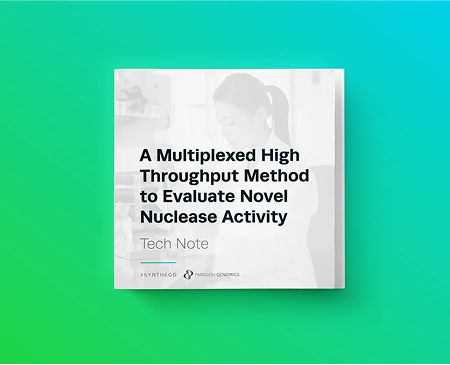A Multiplexed High Throughput Method to Evaluate Novel Nuclease Activity
Explore Synthego and Paragon Genomics technology collaboration evaluating novel nuclease activity
Synthego's expertise and Paragon Genomics technology have been combined to develop a new method to evaluate novel nucleases that enables direct comparison of their editing activity. This tech note takes a closer look at this collaboration displaying the power of Synthego's Halo™ Platform for Synthetic sgRNA and automation capabilities coupled with Paragon Genomics CleanPlex™ amplicon sequencing technology to have a side-by-side comparison of the activity of nucleases. Data is provided.
Since its discovery, the CRISPR-Cas9 system, notably SpCas9, has been the gold standard for gene editing in basic research, generating multiple cell and organism models, preclinical drug discovery pipelines, and the human gene therapy space. Since then, scientists have expanded the CRISPR toolset by discovering various natural type II and type V nucleases and newly engineered variants that have increased on-target activity and fewer off-targets. The increase in the number of nucleases makes it essential to assess their activity in a high throughput manner comparing them to SpCas9 activity to determine which one is best for your application.
In this Tech Note, we will cover:
- A new high throughput method to evaluate novel nucleases that enables direct comparison of their editing activity.
- How Synthego’s Halo™ Platform for Synthetic sgRNA and automation capabilities coupled with Paragon Genomics’ CleanPlex™ amplicon sequencing technology are leveraged in this new method.
- How the use of a single amplicon pool for multiplex PCR enables the rapid preparation of amplicon libraries for next-generation sequencing, independent of the PAM requirements for the nuclease being screened.
- How this workflow automation reduces the hands-on time for library preparation supporting the rapid evaluation of the editing activity and indel profiles of novel nucleases with high granularity, at numerous genomic targets.
